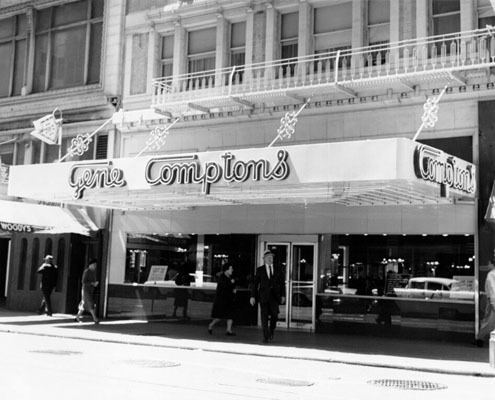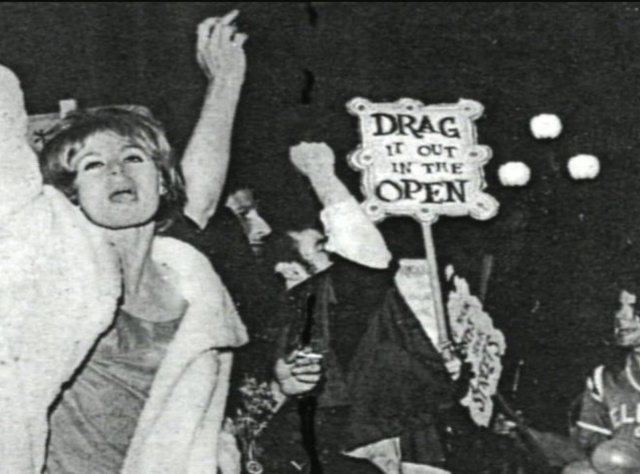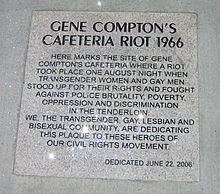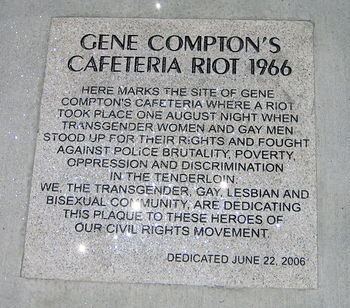 | ||
The Compton's Cafeteria Riot occurred in August 1966 in the Tenderloin district of San Francisco. This incident was one of the first recorded transgender riots in United States history, preceding the more famous 1969 Stonewall Riots in New York City.
Contents

Background

Compton's Cafeteria was one of a chain of cafeterias, owned by Gene Compton, in San Francisco from the 1940s to the 1970s. The Tenderloin location of Compton's at 101 Taylor Street (at Turk)—open from 1954 to 1972—was one of the few places where transgender people could congregate publicly in the city, because they were unwelcome in gay bars, due to transphobia and homonormativity within the LGBT Community at this time. In addition, the cafeteria was open all hours until the riots occurred. Most of the fights occurred from 2-3 am so they were forced to close at midnight. Because cross-dressing was illegal at the time, police could use the presence of transgender people in a bar as a pretext for making a raid and closing the bar.

Many of the militant hustlers and street queens involved in the riot were members of Vanguard, the first known gay youth organization in the United States, which had been organized earlier that year with the help of radical ministers working with Glide Memorial Church, a center for progressive social activism in the Tenderloin for many years. A lesbian group of street people was also formed called the Street Orphans.
Cause of the riot

In the 1960s the Compton’s Cafeteria staff began to call the police to crack down on transgender individuals, who would frequent the restaurant. In response to police arrests, the transgender community launched a picket of Compton’s Cafeteria. Although the picket was unsuccessful, it was one of the first demonstrations against transgender violence in San Francisco. On the first night of the riot, the management of Compton's called the police when some transgender customers became raucous. In the 50's and 60's police officers were known to mistreat transgender people. When one of these known officers attempted to arrest one of the trans women, she threw her coffee in his face. At that point the riot began, dishes and furniture were thrown, and the restaurant's plate-glass windows were smashed. Police called for reinforcements as the fighting spilled into the street, where a police car had all its windows broken out and a sidewalk newsstand was burned down. The exact date of the riot is unknown because 1960 police records no longer exist and the riot was not covered by newspapers.

The next night, more transgender people, hustlers, Tenderloin street people, and other members of the LGBT community joined in a picket of the cafeteria, which would not allow transgender people back in. The demonstration ended with the newly installed plate-glass windows being smashed again.
Effects of the riot
The riot marked a turning point in the local LGBT movement. According to the online encyclopedia glbtq.com:

In the aftermath of the riot at Compton's, a network of transgender social, psychological, and medical support services was established, which culminated in 1968 with the creation of the National Transsexual Counseling Unit [NTCU], the first such peer-run support and advocacy organization in the world.
Serving as an overseer to the NTCU was Sergeant Elliott Blackstone, designated in 1962 as the first San Francisco Police Department liaison to what was then called the "homophile community." According to Susan Stryker, Compton’s Cafeteria riot was “the first known incident of collective militant queer resistance to police harassment in U.S. history." Transgender people finally stood up to the abuse and discrimination by police officers. The riot "did not solve the problems that transgender people in the Tenderloin faced daily", but prompted the city to begin addressing them as citizens rather than as a problem to be removed. Police brutality towards them decreased over time, and they had less fear of being heckled by the police department for dressing how they chose during the daytime.
On June 24, 2016, at the conclusion of the San Francisco Trans March, a new street sign was unveiled, renaming the 100 block of Taylor Street to Gene Compton's Cafeteria Way.
In August 2016, a number of events were held to celebrate the 50th anniversary of the riot, including a gathering in Boeddeker Park in the Tenderloin.
